When Michael Jackson’s Thriller (music video) premiered on December 2, 1983, it did not merely debut; it erupted as a cultural phenomenon that transcended the conventional boundaries of music television. Directed by John Landis, who was renowned for his work on “An American Werewolf in London,” the “Thriller” video was an ambitious project that combined film-level storytelling with groundbreaking special effects and choreography, setting a new benchmark for what music videos could achieve.
At its core, “Thriller” was more than just a promotional tool for Michael Jackson’s album of the same name, which had already achieved significant success following its release in November 1982. The album had topped the Billboard 200 for months and spawned hit singles like “Billie Jean” and “Beat It,” each accompanied by their own popular videos. However, “Thriller” was different; it was a 14-minute short film that showcased Jackson not only as a talented musician but as a versatile performer capable of driving a narrative with his charisma and dance moves.
The video’s release was a spectacle, drawing attention not only for its narrative arc, which featured Jackson dancing with a horde of zombies, but also for its high production values. It references numerous horror films and iconic imagery, making it a staple of pop culture that has been endlessly analyzed, imitated, and discussed. The red jacket worn by Jackson, designed by Deborah Nadoolman, became an iconic piece of pop culture memorabilia, and the dance moves choreographed by Michael Peters became part of the global lexicon.
“Thriller” elevated the music video format to an art form, proving that a music video could be a major event and a powerful medium for storytelling. Its impact on pop culture was immediate and profound, setting the stage for music videos to become essential artistic statements in the music industry. This video not only enhanced Michael Jackson’s status as a global superstar but also forever changed how music was consumed and appreciated worldwide.
| Aspect | Details |
|---|---|
| Premiere Date | December 2, 1983 |
| Director | John Landis |
| Type | 14-minute short film |
| Key Features | Film-level storytelling, groundbreaking special effects, choreography |
| Album Success | Top of Billboard 200, hit singles like “Billie Jean” and “Beat It” |
| Pop Culture Impact | Red jacket, zombie dance moves, high production values |
| Cultural Significance | Elevated music videos to an art form, major event in music industry |
Contents
Background
Before the monumental release of “Thriller,” Michael Jackson had already established himself as a significant figure in the world of music. His career began at a young age with the Jackson 5, where he gained early fame. By the time he released his fifth studio album, “Off the Wall” in 1979, Jackson had matured into a full-fledged solo artist, demonstrating remarkable vocal and dance skills that captivated audiences worldwide. “Off the Wall” was a critical and commercial success, laying the groundwork for his burgeoning solo career and setting the stage for his subsequent albums.
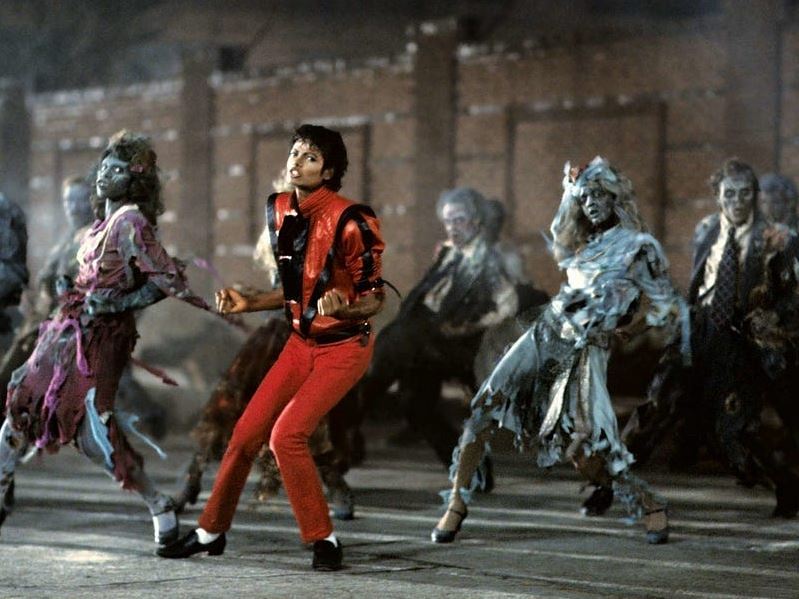
Released in November 1982, “Thriller” quickly became a monumental success. It spent months at the top of the Billboard 200, backed by successful singles such as “Billie Jean” and “Beat It,” both of which were complemented by groundbreaking music videos that helped redefine the music industry. The album not only showcased Jackson’s exceptional talent and innovative sound but also featured collaborations with legendary producers and musicians. This fusion of styles and Jackson’s charisma led “Thriller” to break numerous records, eventually becoming the best-selling album of all time.
Despite the album’s success, Jackson was determined to maintain its momentum. In July 1983, when “Thriller” was temporarily bumped from the top chart position, Jackson’s manager, Frank DiLeo, proposed the idea of making a music video for the title track to revitalize the album’s sales. This idea sparked what would soon become one of the most iconic moments in music video history.
| Event | Details |
|---|---|
| Early Career | Began with the Jackson 5, gaining early fame as a child artist. |
| First Major Solo Success | Released “Off the Wall” in 1979, marking his transition to a mature solo artist. |
| “Off the Wall” Impact | Critical and commercial success, setting the stage for future albums. |
| Release of “Thriller” | Released in November 1982, became a monumental success and the best-selling album of all time. |
| Key Singles from “Thriller” | “Billie Jean” and “Beat It,” both with groundbreaking music videos. |
| Revitalizing “Thriller” Sales | In July 1983, the idea for a music video for “Thriller” was proposed to boost album sales. |
| Impact of Music Video | Propelled “Thriller” back into the limelight, leading to an iconic music video that reshaped the industry. |
Development of the Music Video
The concept for the “Thriller” video was a collaborative effort between Michael Jackson and film director John Landis. Jackson, inspired by the narrative depth and high production values of feature films, wanted the “Thriller” video to transcend traditional music videos in terms of storytelling and scale.
Jackson chose John Landis to direct the video after being impressed by Landis’ film “An American Werewolf in London.” Their partnership was pivotal, combining Landis’ expertise in filmmaking with Jackson’s artistic vision and performance dynamism. This collaboration was crucial in shaping the video’s ambitious scope.
The makeup effects and transformation scenes in “An American Werewolf in London” heavily influenced Jackson and Landis. They envisioned “Thriller” as a short film with a compelling story that could integrate music, dance, and cinematic effects. The iconic werewolf transformation scene from Landis’ film inspired similar effects in “Thriller,” where Jackson transforms into a werecat and a zombie.
Jackson and Landis did not see “Thriller” as just another music video but as a short film. This vision included scripted dialogue, a narrative arc, and complex character development, all woven into the framework of the song.
Despite the initial success of “Thriller,” the music industry was initially reluctant to fund the video. Most stakeholders saw it as an unnecessary risk, especially since the album was already performing well.
The breakthrough came when MTV and the newly launched channel Showtime expressed interest in the project. Showtime offered to finance half of the budget if MTV could cover the remainder. This deal was unprecedented at the time and highlighted the potential of music videos as a serious commercial venture.
The video was shot in various iconic locations around Los Angeles, including the Palace Theatre and East Los Angeles. The production involved extensive logistical arrangements, from choreographing the famous zombie dance sequences to managing the complex makeup and special effects.
The production of “Thriller” faced several challenges, from budget overruns to the physical demands of the elaborate dance sequences. Anecdotes from the set highlight the intensive effort involved, such as the lengthy makeup sessions for the zombie transformations and Jackson’s commitment to achieving perfection in every scene. These stories from the set not only underscore the ambitious nature of the project but also the dedication of everyone involved, which ultimately contributed to the video’s historic success.
| Aspect | Details |
|---|---|
| Concept Development | Collaboration between Michael Jackson and John Landis, inspired by narrative films, particularly “An American Werewolf in London”. |
| Director Selection | Michael Jackson chose John Landis after being impressed by Landis’ work on “An American Werewolf in London”. |
| Special Effects Influence | Inspired by the werewolf transformation scenes in Landis’ film, used similar effects for Jackson’s transformation in “Thriller”. |
| Vision for the Video | Envisioned as a short film with a compelling story, integrating music, dance, and cinematic effects. |
| Funding Challenges | Initial reluctance from the industry to fund the video. Breakthrough funding from MTV and Showtime, covering half the budget each. |
| Shooting Locations | Shot in iconic locations around Los Angeles, including the Palace Theatre and East Los Angeles. |
| Production Challenges | Faced budget overruns, extensive logistics for choreography, and the demands of makeup and special effects. |
| Cultural Impact | The production’s ambition and execution contributed to its historic success and reshaped the music video industry. |
Key Elements of the Video
The plot of Michael Jackson’s “Thriller” video unfolds as a cinematic narrative that blends romance with elements of horror. The video opens with a scene set in the 1950s where Jackson and his girlfriend, played by Ola Ray, experience a car breakdown in a wooded area. After an eerie transformation scene where Jackson becomes a werewolf, the narrative shifts to the present day, revealing the earlier scene as a movie that Jackson and his girlfriend are watching in a theater. The horror theme intensifies as they leave the theater; a group of zombies rises from their graves and surrounds them. In a thrilling turn of events, Jackson himself turns into a zombie, leading the undead in a now-iconic dance routine. The climax occurs in an abandoned house where Jackson chases his terrified girlfriend, only for her to awaken and realize it was all a nightmare—or was it? The video ends with Jackson turning to the camera, his eyes now those of a werewolf, suggesting the nightmare was real.
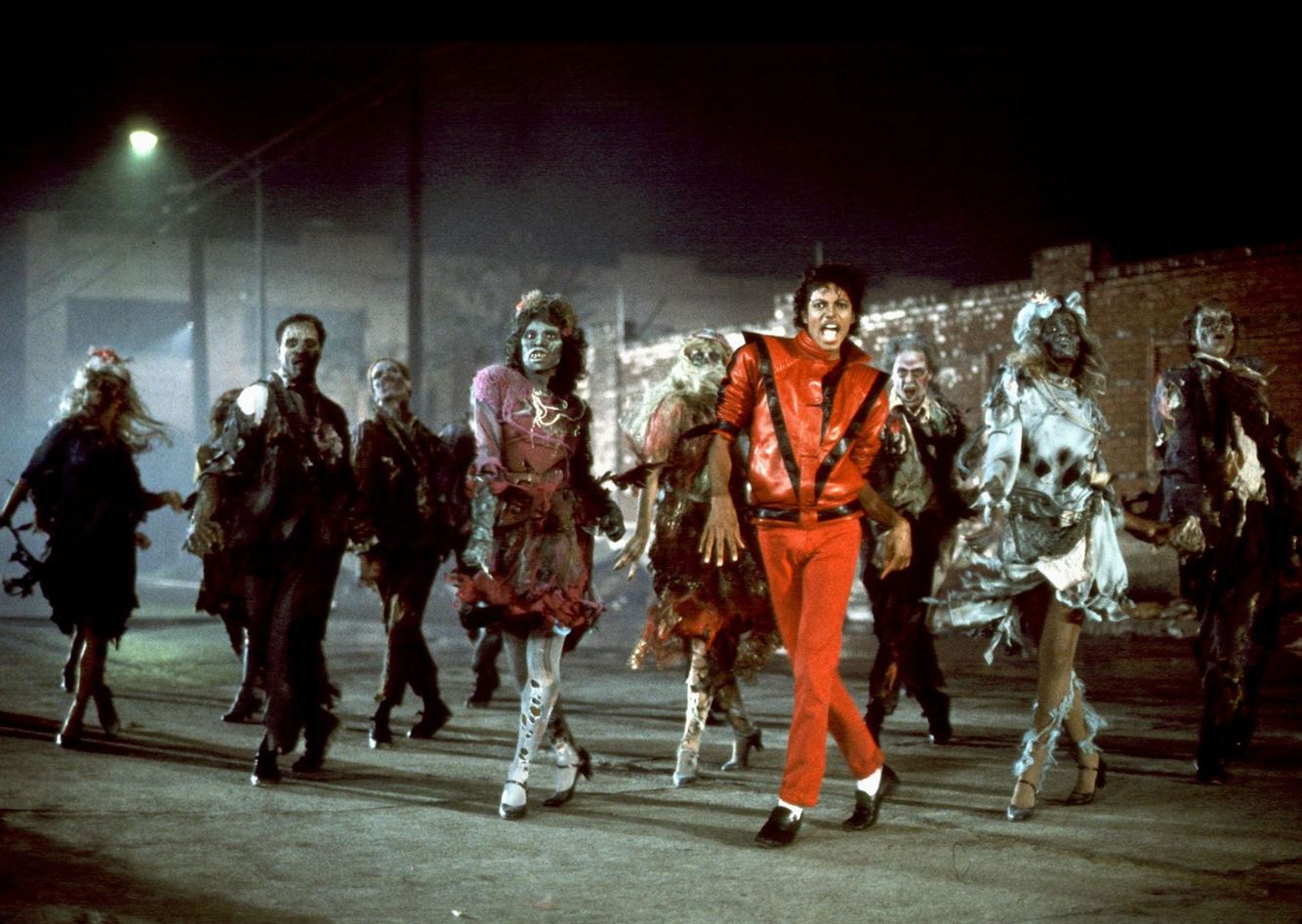
“Thriller” masterfully incorporates traditional horror elements, drawing extensively on cultural references to classic horror films. The transformation scene nods to werewolf movies like “An American Werewolf in London,” while the zombie dance sequence evokes George A. Romero’s “Night of the Living Dead.” These elements are seamlessly integrated with Jackson’s music and dance, creating a unique blend that plays on themes of metamorphosis and the macabre, tapping into the universal appeal of horror and mystery.
The special effects in “Thriller,” particularly the makeup and the transformation sequences, were revolutionary at the time. Pioneered by makeup artist Rick Baker, these effects not only enhanced the visual impact of the video but also set new standards in the music video industry. The use of prosthetics and makeup to alter Jackson’s appearance created vivid and lasting images that significantly contributed to the video’s eerie and thrilling atmosphere.
| Aspect | Details |
|---|---|
| Opening Scene | Set in the 1950s, Michael Jackson and Ola Ray experience a car breakdown in a wooded area. Jackson transforms into a werewolf. |
| Plot Twist | The werewolf scene is revealed to be a movie that Jackson and his girlfriend are watching in a theater. |
| Zombie Scene | After leaving the theater, they encounter zombies rising from graves, leading to Jackson turning into a zombie and dancing with them. |
| Climax | Occurs in an abandoned house where Jackson, as a zombie, chases his girlfriend. She wakes up to realize it was a nightmare—or was it? |
| Ending | Video ends with Jackson turning to the camera with werewolf eyes, suggesting the nightmare was real. |
| Horror Influences | Draws on classic horror films, including transformations akin to “An American Werewolf in London” and zombie elements from “Night of the Living Dead”. |
| Special Effects | Revolutionary effects by Rick Baker, including prosthetics and makeup that transformed Jackson’s appearance. |
| Cultural Impact | Blended music, dance, and horror to create a unique, culturally impactful video that set new industry standards. |
Iconography
The red jacket worn by Jackson in “Thriller” has become one of the most iconic pieces of clothing in music history. Designed by Deborah Nadoolman, the jacket’s vibrant color contrasts starkly with the dark, somber tones typical of horror, making Jackson instantly recognizable and highlighting his central role in the dance sequences. The jacket not only influenced fashion trends but also became a symbol of Jackson’s immense influence in popular culture.
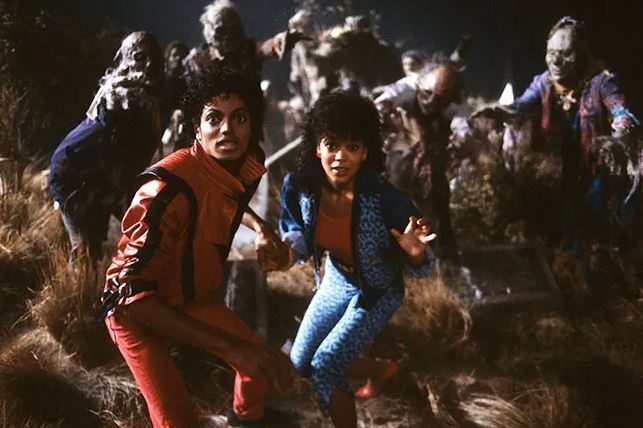
The choreography of the zombie dance in “Thriller,” created by Michael Peters, is highly symbolic and an integral part of the video’s success. The dance represents a fusion of the living and the undead, a metaphor for the song’s themes of horror and survival. This sequence has been widely parodied, imitated, and revered, often serving as a cultural reference point for collective dance movements and flash mobs worldwide.
| Element | Details |
|---|---|
| Red Jacket | Designed by Deborah Nadoolman, the vibrant red color contrasts with the dark horror themes, making Jackson highly recognizable and emphasizing his central role. |
| Cultural Impact of Jacket | Became a symbol of Jackson’s influence in pop culture, influencing fashion trends globally. |
| Zombie Dance Choreography | Created by Michael Peters, represents a fusion of living and undead, symbolizing themes of horror and survival. |
| Cultural Significance of Dance | Widely parodied and imitated; often used as a reference for collective dance movements and flash mobs, emphasizing its impact on popular culture. |
Reception and Impact
The premiere of “Thriller” was an event in itself, attended by celebrities and industry insiders. Its broadcast debut on MTV was met with unprecedented viewer numbers, and it became a fixture on the channel, significantly boosting its popularity and reach. The video was instrumental in making MTV a cultural phenomenon of the 1980s.
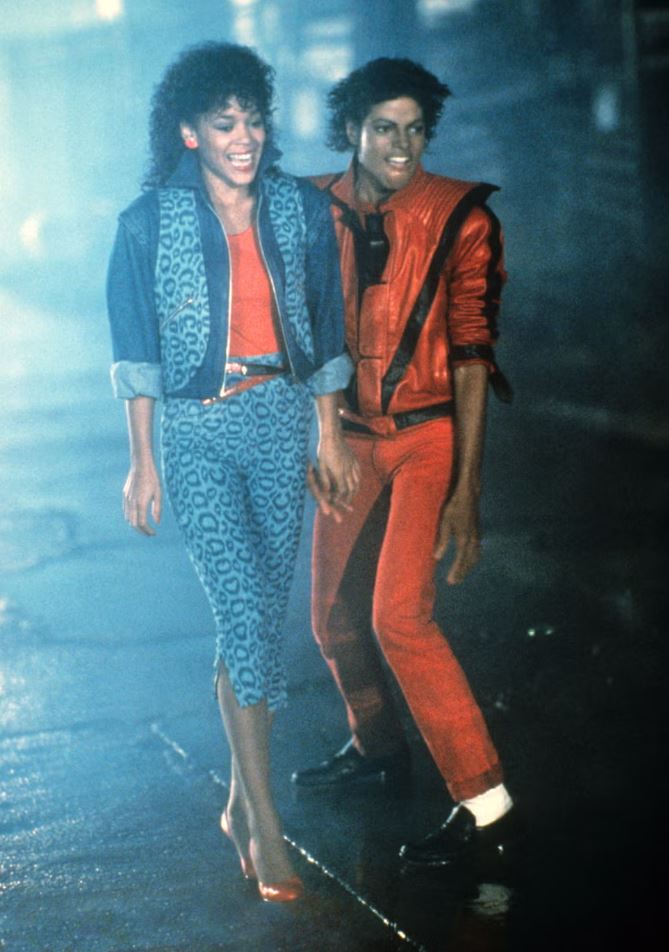
Following the release of the music video, the “Thriller” album saw a significant surge in sales, reaffirming its position at the top of the charts and cementing its status as the best-selling album of all time. The video played a crucial role in revitalizing the album’s commercial prospects and extending its longevity on the charts.
| Event | Details |
|---|---|
| Premiere | Attended by celebrities and industry insiders, marking a significant cultural event. |
| MTV Debut | Unprecedented viewer numbers upon its broadcast on MTV, becoming a regular fixture on the channel and boosting its popularity. |
| Impact on Album Sales | The release of the music video led to a significant surge in sales of the “Thriller” album, reestablishing its position at the top of the charts. |
| Cultural Impact | The video was instrumental in making MTV a cultural phenomenon of the 1980s and played a key role in revitalizing the album’s commercial prospects. |
Critical Acclaim and Criticisms
“Thriller” received numerous awards and accolades, including a record-breaking twelve nominations at the 1984 MTV Video Music Awards, where it won for Best Overall Performance and Best Choreography. It was also recognized at the Grammy Awards, highlighting its broad artistic and technical achievements.
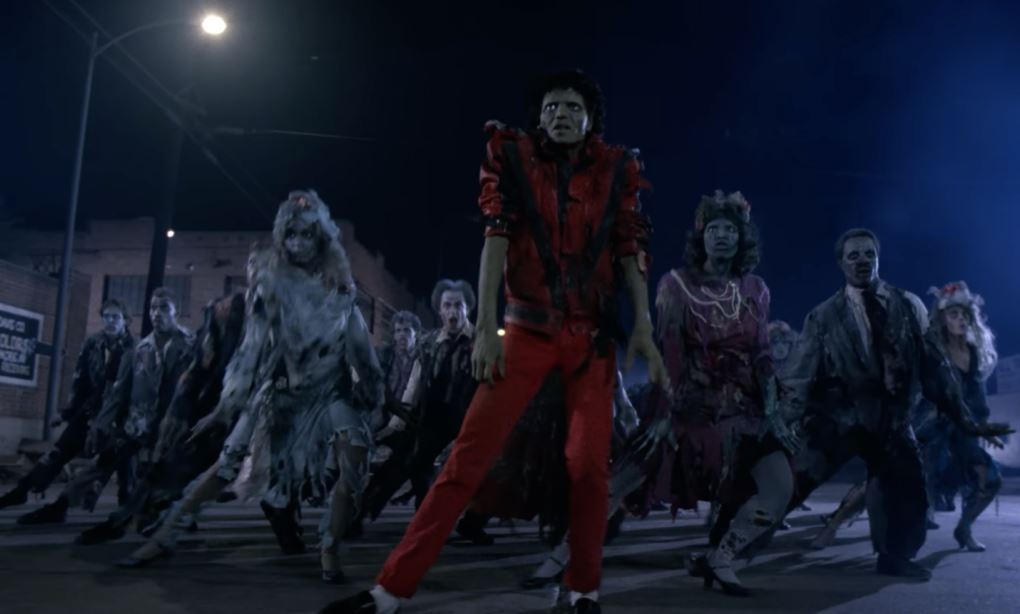
Despite its success, “Thriller” faced its share of criticisms and controversies, particularly from the Jehovah’s Witnesses, to which Jackson briefly belonged. The video’s occult themes led to a backlash from the organization, prompting Jackson to include a disclaimer in the video stating that it did not endorse a belief in the occult. This controversy highlighted the tension between Jackson’s artistic ambitions and his personal and public personas.
| Aspect | Details |
|---|---|
| Awards and Accolades | Received twelve nominations at the 1984 MTV Video Music Awards, winning for Best Overall Performance and Best Choreography. Also recognized at the Grammy Awards. |
| Controversies | Faced criticism from the Jehovah’s Witnesses due to its occult themes, leading to the inclusion of a disclaimer in the video. |
| Impact of Controversy | Highlighted the tension between Jackson’s artistic ambitions and his personal and public personas. |
Legacy
Michael Jackson’s “Thriller” remains a monumental achievement in the history of music videos, redefining the potential of this medium. Its narrative depth, high production values, and seamless integration of storytelling and performance set a new standard for what music videos could be. Beyond its immediate impact on music, “Thriller” profoundly influenced the horror genre, infusing it with a new aesthetic that made horror accessible and appealing to a broader audience. The video’s use of horror elements like zombies and werewolves, coupled with catchy music and choreography, created a hybrid genre that has influenced numerous films and music videos since.
The zombie dance sequence in “Thriller” has transcended its original context to become a global cultural phenomenon. It is performed worldwide at events such as Halloween parties, flash mobs, and dance competitions, illustrating how deeply embedded it has become in popular culture. This dance has not only entertained but also served as a bonding tool, bringing people together across different cultures and generations.
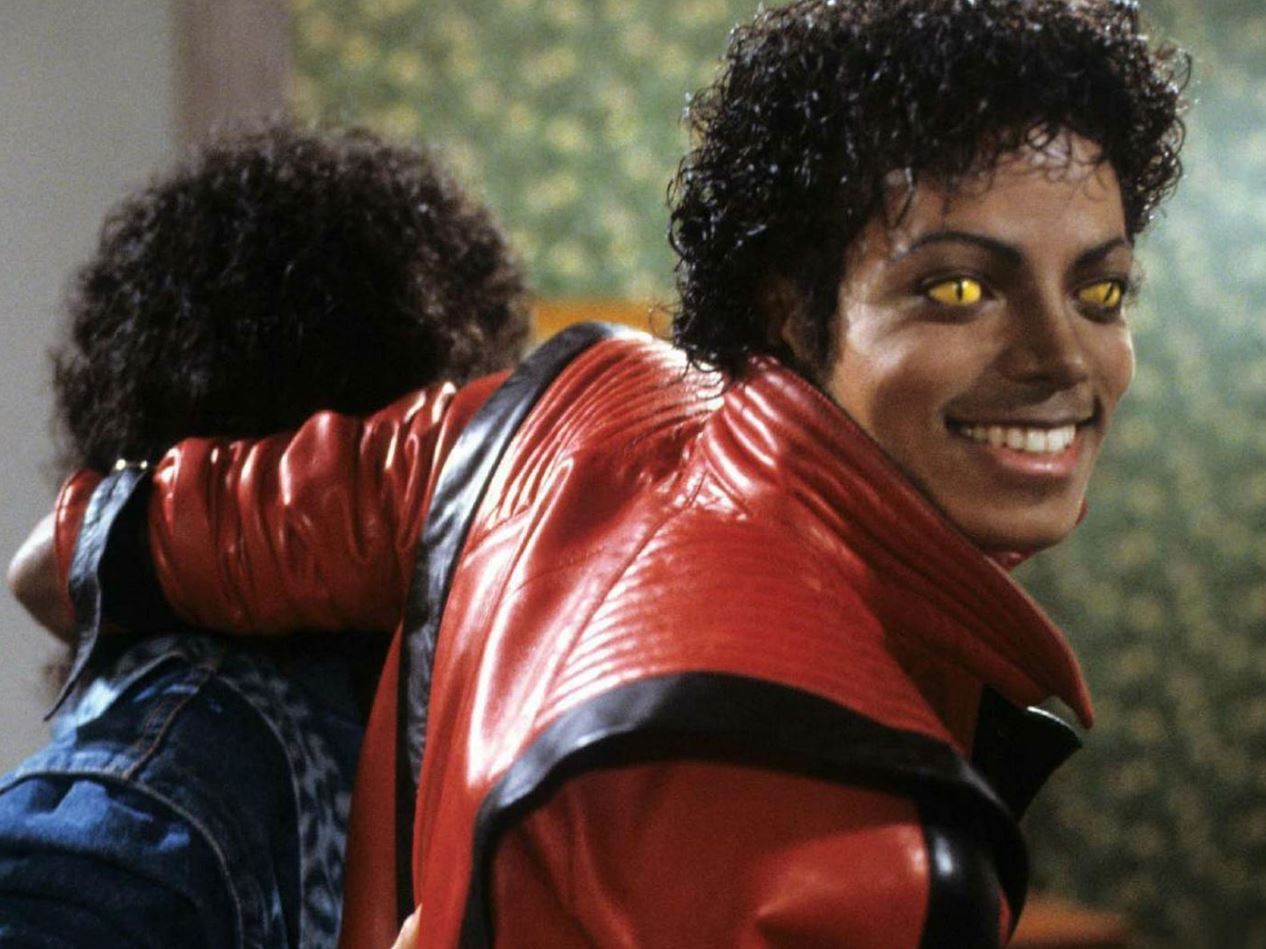
“Thriller” also played a pivotal role in popularizing the making-of documentary format. The behind-the-scenes documentary “Making Michael Jackson’s Thriller” was itself a huge commercial success, providing audiences a glimpse into the production complexities of music videos. This opened up a new revenue stream for artists and production companies, as fans were willing to pay to see how their favorite music videos were made, thereby adding a new layer to the music video experience.
Moreover, the success of “Thriller” and its documentary encouraged the music and entertainment industries to invest more heavily in music videos as a form of home entertainment. Before “Thriller,” music videos were primarily promotional tools meant to boost radio play and album sales. After “Thriller,” they were seen as lucrative products in their own right, capable of driving significant sales of VHS tapes and later DVDs, paving the way for video albums and visually oriented releases.
| Aspect | Details |
|---|---|
| Narrative and Production | Redefines music video potential with narrative depth and high production values, setting new standards for the integration of storytelling and performance. |
| Influence on Horror Genre | Infused the horror genre with a new aesthetic, making it accessible and appealing to a broader audience through the use of elements like zombies and werewolves. |
| Global Cultural Phenomenon | The zombie dance sequence has become a global cultural phenomenon, performed at diverse events and contributing to cross-cultural bonding. |
| Impact on Documentary Format | Popularized the making-of documentary format with “Making Michael Jackson’s Thriller,” opening new revenue streams for the industry. |
| Shift in Music Video Perception | Transformed music videos from promotional tools to lucrative products, influencing the sale of VHS tapes and DVDs, and encouraging video albums and visually oriented releases. |
The legacy of Michael Jackson’s “Thriller” is multifaceted. It transformed music videos into an art form and a critical part of an artist’s promotional arsenal. It also broke new ground in how music could merge with narrative and visual arts, creating a spectacle that remains unmatched in its ambition and execution. The global impact of “Thriller” continues to resonate, influencing not just musicians and filmmakers but also dancers, fashion designers, and pop culture enthusiasts worldwide.
Michael Jackson’s vision for “Thriller” was revolutionary. He did not just aim to entertain but to innovate and transcend traditional media boundaries. His collaboration with John Landis and the adoption of cinematic techniques challenged other artists and directors to think more expansively about music video production. Jackson’s foresight in combining music, film, and dance into a single compelling package was a game-changer in the entertainment industry.
“Thriller” was more than a music video; it was a cultural event that showcased Jackson’s genius and his ability to connect with audiences around the globe. It remains a testament to his creativity and artistic vision, ensuring his place as a pivotal figure in the annals of music and popular culture. The enduring popularity of “Thriller” confirms that Michael Jackson’s artistic contributions continue to inspire and entertain, making the video as much a part of his legacy as his music itself.

